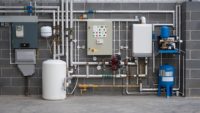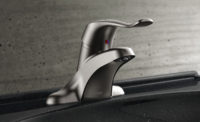Often when you think about commercial building trends, you immediately think about design and architecture.
However, some of the biggest trends today have a direct impact on plumbing engineers and will affect the products you specify and the systems you design.
Trend 1: Low-flow fixtures in hotels
The hotel industry has been on the search for the lowest-flow fixtures available, and that’s not a surprise given the fact that water is the second largest utility cost for hotels. Unfortunately, the valves engineers are specifying for the low-flow showerheads could cause problems.
The ASSE 1016-2017/ASME A112.1016-2017/CSA B125.16-2017 standard requires manufacturers to obtain certification for their shower valves at their stated minimum flow rates. Unfortunately, if the manufacturer does not state a minimum flow in their literature, then the certification lab will default to a minimum flow rate of 2.5 gpm.
Ask yourself how many times you’ve specified a low-flow showerhead vs. a 2.5-gpm showerhead in the last year? We caution you to be aware and read your submittals carefully to verify the valve’s minimum flow rating is equal to or less than that of the showerhead being specified. This is the only way to ensure effective and safe temperature control in accordance with the required performance standard.
Another area of low-flow concern is when a facility changes old 1.5-gpm lavatory aerators with lower-flow alternates (i.e. 0.5 gpm). The ASSE 1070-2015/ASME A112.1070-2015/CSA B125.70.15 standard dictates valves must be used at public faucets to ensure proper and safe temperature control. This standard went a step further than ASSE 1016 by eliminating the default flow rate, and requires manufacturers to publish their certified minimum flow. This makes the selection of valves and faucets more straightforward. Secondly, a facility that was designed for higher flow faucets will have line sizes designed for this scenario. Unfortunately, when the flow is reduced, the time it takes to get hot water from the tank/hot water main to the fixture is increased proportionally.
Generally, people are not willing to stand around, waiting 15-20 seconds for the water to get hot. And to further complicate things, a typical sensor faucet only runs for five or 10 seconds. In these situations, instantaneous water heaters can provide an excellent solution for both showers and lavatories by eliminating the need to wait around and waste either cold or hot water. However, like the valves we discussed earlier, you need to select a heater that will perform at the low flows being specified to ensure they will turn on and heat the water. This also helps to minimize the problem of lukewarm water lying in the pipes, which is a perfect breeding ground for the Legionella bacteria. That brings us to our next trend.
Trend 2: New ways to fight Legionella
The CDC reports that Legionnaires’ disease has been on the rise since 2000. While outbreaks typically occur in buildings or structures that have complex water systems, such as hotels, resorts, cruise ships and prisons, a large percentage of the reported cases occur in healthcare facilities.
A building doesn’t have to be old to harbor the bacteria. Just this past May, an outbreak of Legionnaire’s occurred in the newly built Mount Carmel Grove City Hospital just days after the facility opened. At the time this article was written, 10 patients contracted the disease, and one person died.
On a building owner’s list of problems to be avoided, Legionella always is near the top. The traditional approach to preventing the growth and/or spread of the bacteria includes regular testing, chemical treatment, proper temperature control and/or running recirculation pumps continuously. This becomes even more critical in the case of healthcare facilities where patients often have a weakened immune system.
To help combat this issue, smart technology provides better prevention and control methods. Digital mixing valve systems provide facilities a way to monitor water temperatures within their facility, and to set up alarms and alert notifications when conditions are conducive for Legionella growth. This enables a facility to head off problems before they occur, but totally eradicating the Legionella bacteria has proven difficult. When the bacteria is detected, most digital valve systems allow you to remotely adjust and increase system temperatures to help sanitize the system, killing bacteria within the pipes and fixtures when flushed properly.
Combined with digital technology, thermostatic mixing valves at each fixture will compensate for this increase in water temperature and help to prevent scalding at fixtures. Unfortunately, each fixture must then be adjusted to allow full hot water to kill the bacteria that remains in/at the fixture itself. This leaves the potential of surviving bacteria in the cold water supply, but as digital mixing solutions continue to evolve and manufacturers adapt control algorithms, this prevention technique will improve and close this gap. In the meantime, manufacturers are continually working to improve point-of-use filters, chemical treatment protocols and water management plans to address this shortcoming.
Trend 3: Reducing stigma through Universal Design
Another trend we are seeing in hotel guest rooms and healthcare patient rooms is a move toward Universal Design. It’s a concept that says spaces should be designed to meet the needs of all people who wish to use it, regardless of their age, size or ability.
Typically, a hotel will have only a handful of rooms that are mobility accessible. Hospitals will similarly have specific patient rooms designated for bariatric care or for patients who have a high risk of suicide.
The Joint Commission, a nonprofit organization that accredits and certifies healthcare organizations in the United States, has been paying particular attention to the safety of patients with a high risk for suicide. Healthcare facilities do not want to run the risk of losing Medicare and Medicaid funding by running afoul of the Joint Commission, but even more — they do not want to put vulnerable patients in a room that contains fixtures and accessories which could be used to support a noose or other strangulation device, known as ligature points.
Bathrooms are a particular hazard as, according to a Joint Commission study, about half of the 49 to 65 suicides that occur annually in in-patient units in the U.S., take place in the bathroom. Hanging accounts for about 70% of those suicides.
With the availability of ligature-resistant products designed to look like something you might find in your home or a hotel room, there is no reason they cannot replace traditional fixtures and accessories. Not only do these products eliminate ligature points, but some are also ADA compliant and meet bariatric requirements.
Universal Design allows hotels and healthcare facilities the flexibility of assigning rooms to guests and patients of all abilities without the need to stigmatize the individual. No longer does the facility run the risk of keeping rooms unoccupied, just in case, or running out of designated rooms for individual situations.
In the end, all these trends come down to one thing — safety. The better an engineer can understand what’s behind these trends, the better you can assist your customer by specifying the appropriate products for all situations.
Not only will you be helping to save lives and prevent injury, but you could be protecting your customer, and possibly your company, from catastrophic lawsuits down the road.





